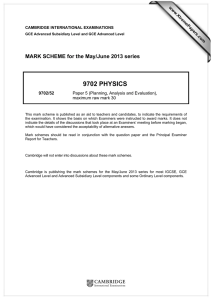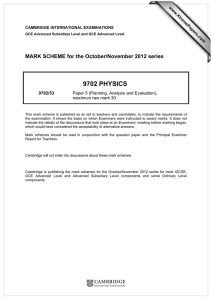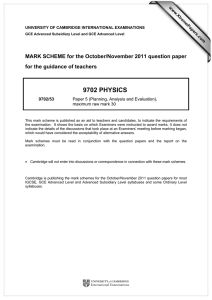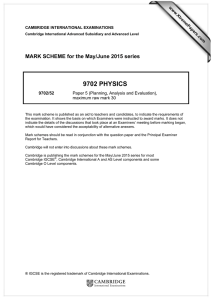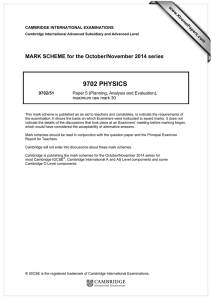9702 PHYSICS MARK SCHEME for the October/November 2014 series
advertisement
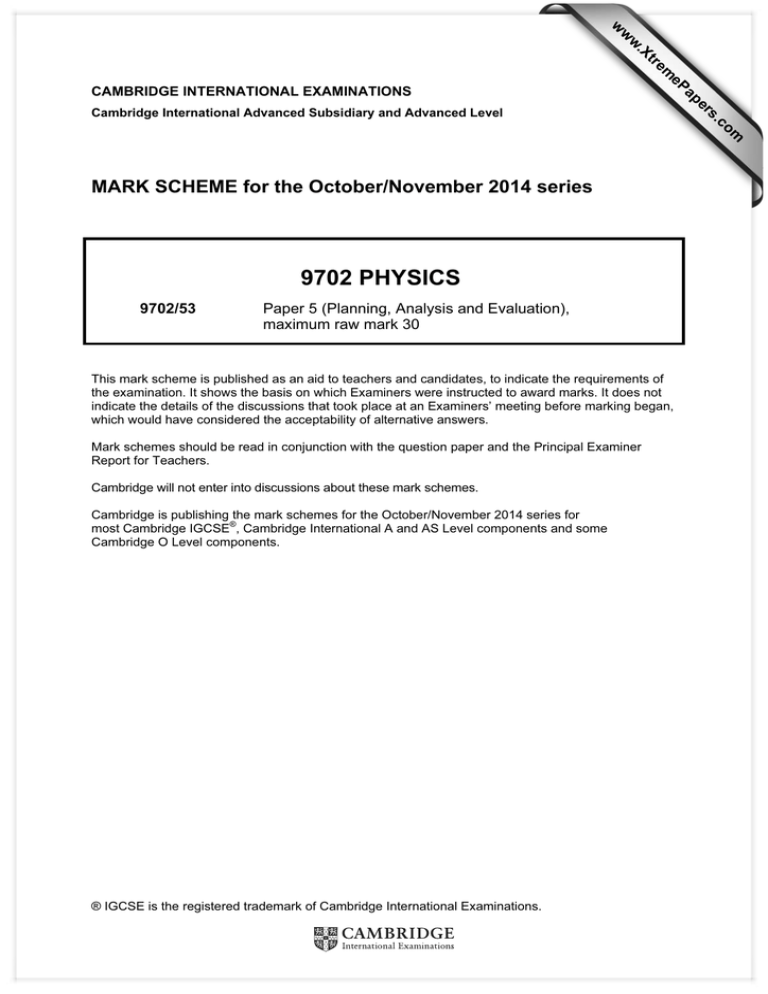
w w ap eP m e tr .X w CAMBRIDGE INTERNATIONAL EXAMINATIONS om .c s er Cambridge International Advanced Subsidiary and Advanced Level MARK SCHEME for the October/November 2014 series 9702 PHYSICS 9702/53 Paper 5 (Planning, Analysis and Evaluation), maximum raw mark 30 This mark scheme is published as an aid to teachers and candidates, to indicate the requirements of the examination. It shows the basis on which Examiners were instructed to award marks. It does not indicate the details of the discussions that took place at an Examiners’ meeting before marking began, which would have considered the acceptability of alternative answers. Mark schemes should be read in conjunction with the question paper and the Principal Examiner Report for Teachers. Cambridge will not enter into discussions about these mark schemes. Cambridge is publishing the mark schemes for the October/November 2014 series for most Cambridge IGCSE®, Cambridge International A and AS Level components and some Cambridge O Level components. ® IGCSE is the registered trademark of Cambridge International Examinations. Page 2 1 Mark Scheme Cambridge International AS/A Level – October/November 2014 Syllabus 9702 Paper 53 Planning (15 marks) Defining the problem (3 marks) P t is the independent variable or vary t. [1] P V is the dependent variable or measure V. [1] P Keep the current (in the primary coil) constant. [1] Methods of data collection (5 marks) M Diagram showing two independent labelled coils wound on iron cores. [1] M AC power supply / signal generator connected to one coil. [1] M Voltmeter / oscilloscope connected to other coil in a workable circuit. [1] M Measure thickness of card using micrometer / vernier calipers / digital calipers. [1] M Method to keep current constant – rheostat (or variable power supply) and ammeter correctly positioned in primary circuit and explained. Diagram and text required. [1] Method of analysis (2 marks) M Plot a graph of ln V against t (allow lg V against t) or ln V / V0 against t [1] M σ = – gradient [1] Safety considerations (1 mark) S Precaution linked to hot coil(s) e.g. switch off when not in use / do not touch / wear gloves. [1] Additional detail (4 marks) D Relevant points might include [4] 1 Use large current (in primary coil)/large number of turns on the secondary to achieve measurable V (allow more turns on secondary than primary). 2 Keep frequency of power supply constant or keep the number of turns on each coil constant. 3 Use laminated cores or use insulated wire for turns. 4 Repeat measurements of t and average. 5 Measurement of V0 stating that no card is present. 6 Logarithmic equation: ln V = ln V0 – σt 7 Relationship is valid if the graph is a straight line with y–intercept = ln V0 8 Discussion of compression of card / measure t when secured. Do not allow vague computer methods. [Total: 15] © Cambridge International Examinations 2014 Page 3 2 Mark Scheme Cambridge International AS/A Level – October/November 2014 Syllabus 9702 Paper 53 Analysis, conclusions and evaluation (15 marks) Mark Expected Answer (a) A1 (b) T1 T2 gradient = Additional Guidance 2g Z v2 / m2 s–2 Allow v2 (m2 s–2) 1.96 or 1.960 2.40 or 2.403 2.72 or 2.723 3.06 or 3.063 3.42 or 3.423 3.80 or 3.803 Must be table values. Allow a mixture of significant figures. U1 From ± 0.1 to ± 0.2 with uncertainties increasing Allow more than one significant figure. G1 Six points plotted correctly Must be within half a small square. Penalise “blobs”. Ecf allowed from table. U2 Error bars in v2 plotted correctly All error bars to be plotted. Must be accurate to less than half a small square. G2 Line of best fit If points are plotted correctly then lower end of line should pass between (0.24, 2.04) and (0.24, 2.10) and upper end of line should pass between (0.42, 3.54) and (0.42, 3.60). Line should not be from top point to bottom point. G3 Worst acceptable straight line. Steepest or shallowest possible line that passes through all the error bars. Line should be clearly labelled or dashed. Examiner judgement on worst acceptable line. Lines must cross. Mark scored only if all error bars are plotted. C1 Gradient of best fit line The triangle used should be at least half the length of the drawn line. Check the read-offs. Work to half a small square. Do not penalise POT. (Should be about 8.4.) U3 Uncertainty in gradient Method of determining absolute uncertainty: difference in worst gradient and gradient. (d) (i) C2 v = gradient × h Gradient must be used (no substitution methods). Should be between 2.39 and 2.46. (ii) U4 1 ∆gradient ∆v × 100 = × 100 2 gradient v Allow ecf from (d)(i). (c) (i) (c) (ii) (c) (iii) © Cambridge International Examinations 2014 Page 4 Mark Scheme Cambridge International AS/A Level – October/November 2014 (e) C3 K in the range 7.20 × 10–4 to 7.80 × 10–4 and given to 2 or 3 s.f. C4 kg m2 U5 Absolute uncertainty in K Syllabus 9702 Paper 53 2g − 1 K = mr 2 gradient Uses worst gradient. Allow ecf. [Total: 15] Uncertainties in Question 2 (c) (iii) Gradient [U3] Uncertainty = gradient of line of best fit – gradient of worst acceptable line Uncertainty = ½ (steepest worst line gradient – shallowest worst line gradient) (d) (ii) [U4] max v = max gradient × h min v = min gradient × h (e) [U5] 2g − 1 max K = mr 2 min gradient 2g − 1 min K = mr 2 max gradient © Cambridge International Examinations 2014

